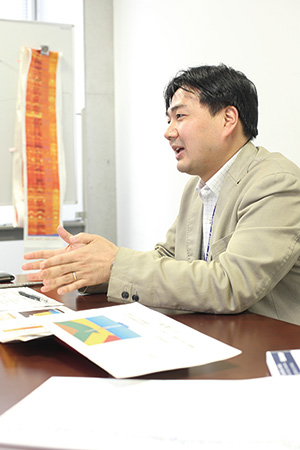Visualization in real-time on board ship

In LWD, data that are acquired through a variety of sensors are recorded and stored in the measuring tool's memory, and afterwards collected and analysed in detail. But in fact that is not the only thing that happens. All acquired data are transmitted in real-time to the CHIKYU on the surface. The total length of the drill pipe linking the drill bit at the bottom and the CHIKYU extended to approx. 5,000 m for this expedition. How are those data transmitted?
The transmission path is formed by the mud that is circulated inside the drill pipe. By switching the mud flow partially on and off through a transmission system in the measuring tool, pulse signals are sent in the form of pressure changes. These are picked up by a received on board ship. Although compared to the data stored in the memory data accuracy etc. is inferior as there are limits to the data volumes that can be transmitted, data that have been measured in the deep earth are still visualized on board ship virtually in real-time.
“This really is live information during drilling. Watching the monitor with the other scientists was a bit nerve-racking,” tells Sanada, who was part of this expedition. For the scientists it will have been the realization of seeing the inside of the earth in real time, spreading the excitement on board.
These data are not only for estimating strata’s physical properties during drilling, but they also carry valuable information for evaluating the drilling situation. In the IODP Expedition 343 which was executed as part of the Japan Trench Fast Drilling (JFAST) project the plate boundary fault zone that caused the massive earthquake was identified through LWD, and it also determined the placement of long-term sensors and the depth of the core retrieval. An enormous amount of valuable information has been obtained during this expedition for the clarification of the seismogenic and tsunamigenic mechanisms in the Nankai Trough.
In the introduction the characteristics of LWD were likened to a medical examination. Looking at for example diagnostic imaging, recent advances mean that minute cancers can be found or a beating heart can be displayed as 3D animation. This will be the same for LWD in the future. There might well be a day in the near future that changes in a fault or movement in the ground water can be visualized in real time. The evolution of LWD carries new possibilities for deep earth exploration.

- |1|
- 2|
